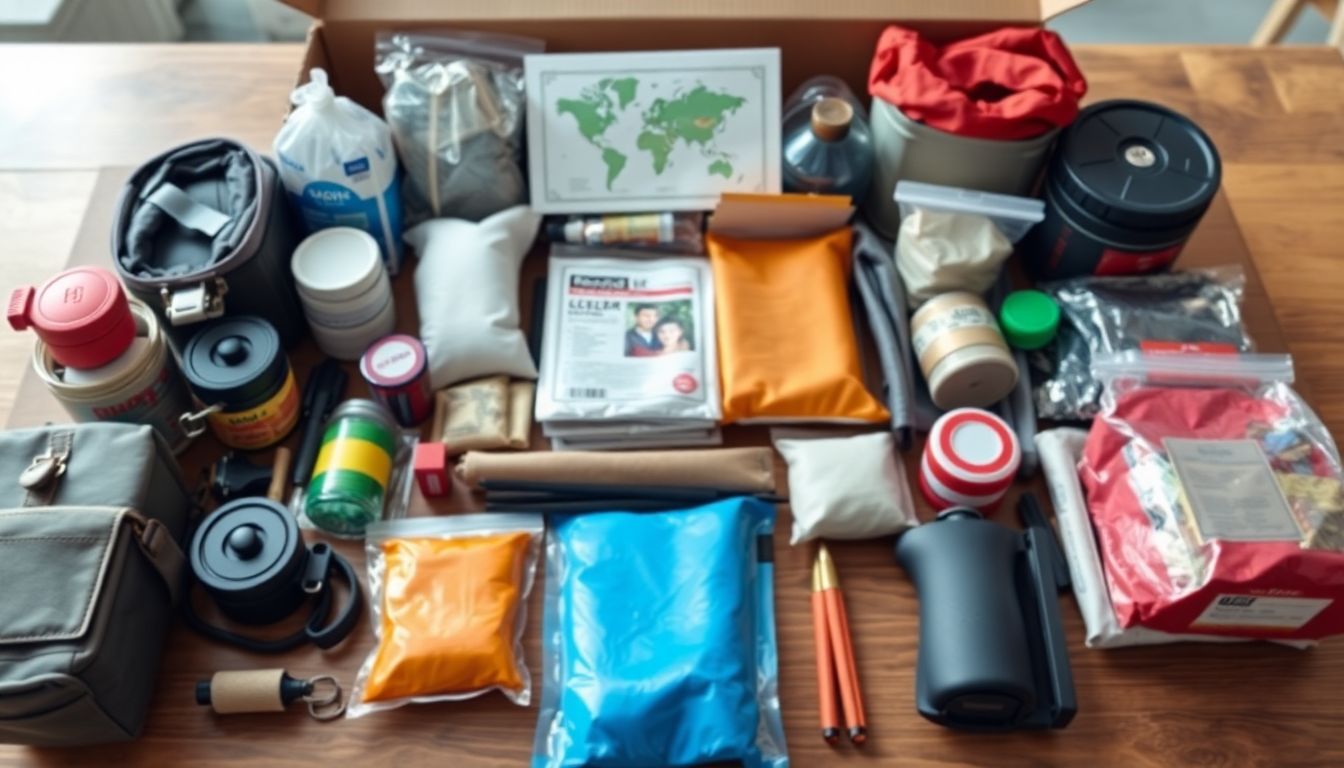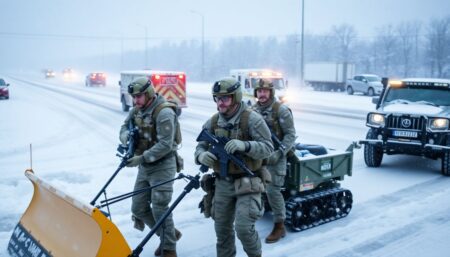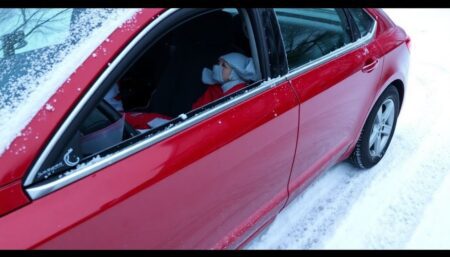Winter driving can be a challenge, especially in regions where snowstorms and freezing temperatures are common. Being prepared for emergencies is crucial, and one of the best ways to ensure your safety is by having a well-stocked winter car survival kit. This article will guide you through the essential items you need to include in your kit, ensuring you’re ready for any winter roadside emergencies.
Don’t get stranded out in the cold – make your own winter car survival kit.
In the stark, frozen tableau of a snowy landscape, a solitary car sits stranded, its tires deeply buried in the unforgiving drifts. The vehicle’s once-glossy paint is now dusted with a thick layer of snow, and its windows are frosted over, obscuring any view of the interior. The car’s angular form stands in stark contrast to the soft, rolling white hills that surround it, as if swallowed by a vast, untouched wilderness. There are no tire tracks leading to or from the vehicle, suggesting that it has been stuck here for some time, abandoned to the elements.
In the foreground, a survival kit lies conspicuously in the snow, its bright red bag a stark contrast against the pristine white backdrop. The kit appears well-stocked, with various essentials spilling out from its open top. A thermal blanket, a small shovel, a flashlight, and a few packets of food rations are visible, hinting at the precautions taken by the driver before embarking on this ill-fated journey. The presence of the kit raises questions: where is the driver, and why was the kit left behind? The scene is a poignant reminder of nature’s unpredictable power and the importance of preparedness in the face of such adversity.

Build Your Own Winter Survival Kit
In the throes of winter, when temperatures plummet and road conditions become unpredictable, having a winter car survival kit can mean the difference between a minor inconvenience and a major emergency. The importance of such a kit cannot be overstated. It ensures that drivers are prepared for a variety of scenarios, from being stranded in snow to dealing with mechanical failures. The kit provides peace of mind and can be a lifesaver in extreme conditions.
A well-equipped winter car survival kit should include a range of items tailored to cold-weather needs. Many of these items might already be in the reader’s garage, making the assembly process more convenient. Here is a brief overview of what should be included:
- A small shovel to dig out of snow
- Sand or cat litter for traction
- A flashlight with extra batteries
- A first aid kit
- Jumper cables
- A multi-tool or pocket knife
- A reflective vest for visibility
- Warm clothing such as gloves, a hat, and a blanket
- Non-perishable food and water
- A whistle to signal for help
- A portable charger for your phone
However, it’s essential to note that while having these items is crucial, they are not a substitute for safe driving habits. Drivers should always check weather conditions before setting out and ensure their vehicle is in good working order. Additionally, some items in the kit may require periodic replacement or maintenance, such as checking the expiration dates on food and ensuring the flashlight batteries are functional. Overall, the winter car survival kit is a necessary precaution that can provide significant benefits in adverse conditions.

Essential Items for Your Kit
A well-equipped winter car survival kit is essential for driving in cold weather conditions, as it enhances safety and preparedness. Some of the most crucial items to include are those that provide warmth and light. A candle-powered heater can generate a surprising amount of heat, making it a low-tech yet effective tool for maintaining warmth in case of a breakdown or emergency. Remember to crack open a window for ventilation when using it. Additionally, a small LED flashlight is indispensable for navigating dark environments, signaling for help, or performing minor repairs. It is compact, energy-efficient, and has a long lifespan.
Communication and visibility are also vital in emergency situations. A cell phone car charger ensures that your mobile device remains powered, enabling you to call for assistance or use navigation apps. Including a notepad and pen can be useful for leaving notes on your vehicle if you have to leave it, or for jotting down important information. To ensure your vehicle remains visible and in good working order, include a safety absorbent to clean up spills, and a portable air compressor along with a fix-a-flat to temporarily repair flat tires.
Lastly, include items that facilitate car repairs, mobility, and personal warmth. A simple tool kit can help you make minor repairs to your vehicle, while a foldable shovel is essential for clearing snow and ice from around your car. To protect against frostbite and hypothermia, pack a warm hat and gloves as well as a warm blanket. The blanket can also provide comfort during prolonged waits. Here’s a summary of the essential items:
- Candle-powered heater
- Small LED flashlight
- Cell phone car charger
- Notepad and pen
- Portable air compressor
- Simple tool kit
- Safety absorbent
- Foldable shovel
- Fix-a-flat
- Warm hat and gloves
- Warm blanket
While these items are crucial, it’s also important to stay informed about weather conditions, maintain your vehicle regularly, and always prioritize safety when traveling during winter.

Pack It All Up
Packing a survival kit for your car is an essential step in ensuring your safety and preparedness during emergencies. When assembling your kit, prioritize items that are crucial for survival and can handle a variety of situations. Start with a sturdy, waterproof container to keep your supplies organized and protected. Include essentials such as
- Non-perishable food items
- Water
- A first aid kit
- A flashlight with extra batteries
- A multi-tool
- A warm blanket
- A reflective emergency blanket
- A whistle for signaling
- A portable charger for your phone
- Jumper cables
- A tire sealant and a portable air compressor
- A small shovel
- A road map
.
Once you have gathered all your items, pack them strategically. Place heavier items at the bottom and lighter items on top for easier access. Ensure that frequently used items, such as the flashlight and multi-tool, are within easy reach. Use smaller containers or bags within the main container to keep items organized and prevent them from shifting during travel. Seal the kit to prevent moisture and keep it securely closed.
Storing your survival kit in an easily accessible location in your car is paramount. The best place to keep it is in the trunk or cargo area, preferably near the back for quick access. Avoid storing it in the passenger compartment, as this can be difficult to reach in an emergency, especially if the car is damaged or you are injured. Ensure that the kit is secure and won’t move around during normal driving conditions. Regularly check and update your kit to replace expired items and add any new supplies you might need. Having your survival kit readily available can make a significant difference in an emergency, providing you with the tools and resources you need to stay safe and increase your chances of survival.
FAQ
Why is it important to have a winter car survival kit?
What should I do if I get stranded in a snowstorm?
- Stay calm and assess the situation.
- Use your cell phone to call for help.
- Stay warm by using blankets, hats, and gloves from your kit.
- Use a candle-powered heater for additional warmth.
- Use a flashlight to signal for help.
How can I prevent my car from getting stuck in the snow?
- Drive slowly and carefully, especially on icy roads.
- Avoid sudden acceleration or braking.
- Use winter tires for better traction.
- Keep your gas tank at least half full to avoid running out of fuel.
- Carry a foldable shovel and safety absorbent in your survival kit to help dig out if you do get stuck.
What should I do if my car won’t start in cold weather?
- Check the battery and ensure it’s fully charged.
- Use a portable air compressor to check tire pressure.
- Use a simple tool kit to check for any loose connections or quick fixes.
- If the problem persists, call for roadside assistance.









